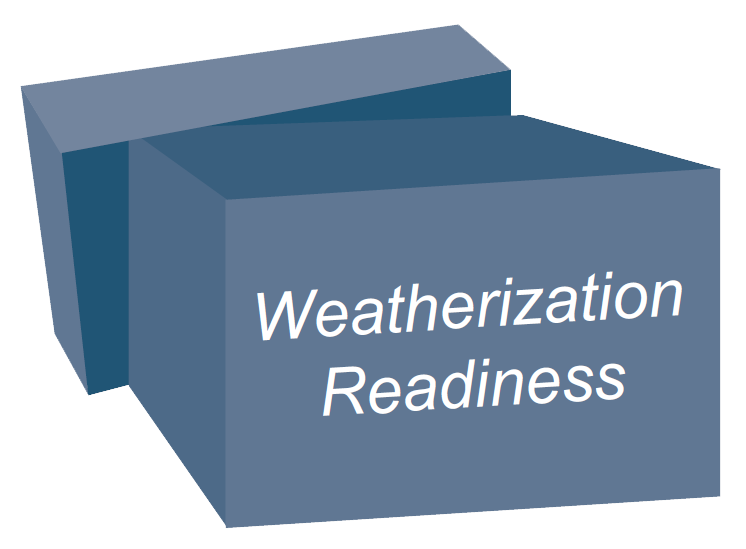Design
See an index of all documents from example states in the Library .
Consider Whether this Program In a Box is Right for Your State
A weatherization readiness program could be a good fit for a state with many households that are unable to participate in the Weatherization Assistance Program due to health and safety barriers.
| Connecticut Residential Energy Preparation Services | Minnesota Healthy AIR Program | |
|---|---|---|
| Identified problem | A whitepaper developed by Energy Futures Group identified that 165,000 homes in the state are unable to receive weatherization services due to health and safety issues with the building. | In 2016, 40% of homes eligible to receive weatherization improvements were unable to benefit due to vermiculite-contaminated insulation in attics. |
Justice40 Considerations
Through Executive Order 14008 which established the Justice40 Initiative, the Biden Administration has set a goal of ensuring that at least 40 percent of the benefits of federal investments flow to disadvantaged communities. Justice40 will have significant implications for hundreds of programs across the federal government, including clean energy , climate, and resilience programs that are overseen by the U.S. Department of Energy (DOE) in partnership with states. State Energy Offices and their partners may wish to consider assessing various dimensions of their programs – including such factors as the ability of disadvantaged and diverse individuals and communities to influence, participate in, and access the benefits of state policies and programs – and explore metrics and reporting strategies that will help illustrate the Justice40 impacts of their policies, programs, and investments. Available resources to support these actions include:
- White House landing page for Justice40
- July 2021 Office of Management and Budget Interim Implementation Guidance for the Justice40 Initiative
- Justice40 Initiative Updates from DOE’s Office of Economic Impact and Diversity
- Guidance on Community Benefits Plans in Proposals for IIJA Funding
- January 2023 Addendum to the Interim Implementation Guidance for the Justice40 Initiative, M-21-28, on using the Climate and Economic Justice Screening Tool (CEJST)
- Instructions for using the Climate and Economic Justice Screening Tool
Through NASEO’s Energy Equity Committee , State Energy Offices can learn about ongoing developments and resources that support federal Justice40 and state energy equity and environmental justice goals.
To help states identify the location of disadvantaged communities, the White House Council on Environmental Quality (CEQ) has developed The Climate and Economic Justice Screening Tool (CEJST) . Instructions for using the tool are linked above.
When designing weatherization readiness programs, priority could be given to training centers located in or serving disadvantaged communities.
Goals and Name
Writing a concise goals statement for a weatherization readiness program both creates internal consensus and serves as an essential tool for communicating with local municipalities and relevant agencies and organizations. Periodic updates to the goal statement memorialize changes in program scale, scope, and specific details.
Giving the program a name is an important step in the process of branding and advertising the program.
Recommendations for a program name:
- Reflect the goals of the program
- Solicit recommendations from participating agencies and organizations
Stakeholder Process
In designing the Weatherization Barriers Remediation Program, the Connecticut Department of Energy and Environmental Protection (DEEP) facilitated a stakeholder input process comprised of contractors, nonprofits, regulators, and utilities to gather suggestions. Resources from that process:
Planning Workshop #1
- Meeting Recording , and Slides
Planning Workshop #2
- Meeting Recording , and Slides
Public Input Session: Bidder’s Conference
- Public Notice , Recording , and Draft RFP
Scope
| Connecticut Residential Energy Preparation Services | Minnesota Healthy AIR Program | |
|---|---|---|
| Health or safety issue | Asbestos, mold, vermiculite, unsafe combustion/venting, gas leaks, carbon monoxide, structural issues, knob and tube wiring | Vermiculite insulation containing asbestos |
Performance Metrics
Program metrics should be defined before the program is implemented. Metrics to consider include specific equity and Justice40 goals, to measure impact on affected communities.
Budget and Program Administration
Before finalizing the program design, consider budget allocations and staffing requirements for agencies involved.
| Connecticut Residential Energy Preparation Services | Minnesota Healthy AIR program | |
|---|---|---|
| Budget | Up to $12,300,000 through December 31, 2024 using multiple funding sources. $5,500,000 is from the Low Income Home Energy Assistance Program, with $6,650,000 in supplemental funding from the 2021 American Rescue Plan Act (ARPA), and up to $150,000 in supplemental funding from State Energy Program funds (SEP). | $300,000 for 2018 and 2019 |
| Program administration and staffing | The Department of Energy and Environmental Protection (DEEP) engaged ICAST to administer the program. | Two staff, Minnesota Department of Commerce |
Eligibility Criteria
A successful program will clearly define which households are able to participate. Some considerations will be pre-determined by utilizing funding sources already targeted to low-income communities through the Weatherization Assistance Program (WAP).
Timeline
Part of the program design is looking at the budget and determining a realistic timeline for getting the program running and selecting the program duration.
- See page 3 of the Program Guidelines for the Minnesota Healthy AIR Program for a sample timeline.

